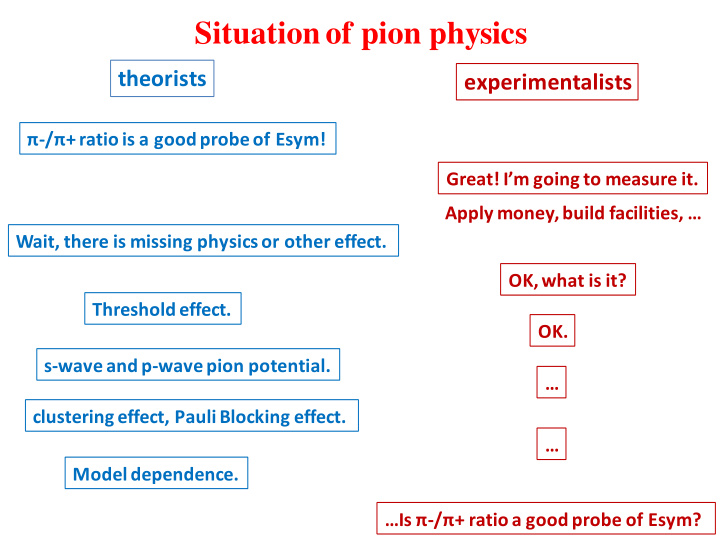



Situation of pion physics theorists experimentalists π -/ π + ratio is a good probe of Esym! Great! I’m going to measure it. Apply money, build facilities, … Wait, there is missing physics or other effect. OK, what is it? Threshold effect. OK. s-wave and p-wave pion potential. … clustering effect, Pauli Blocking effect. … Model dependence. …Is π -/ π + ratio a good probe of Esym?
Talk by Pawel Danielewicz related to Esym Pion optical potential With pBUU Integrated ratio insensitive to Esym Energy spectra sensitive to Esym
Talk by Tetsuya Marukami Considerable experimental efforts 400 MeV/nucleon for pion measurement 600 MeV/nucleon 800 MeV/nucleon Compared with JQMD Call for transport efforts to explain the experimental data
Talk by Natsumi Ikeno Clustering effect on π -/ π + ratio Pauli Blocking effect on π -/ π + ratio With JAM
Talk by Mircea Dan Cozma LEC: local energy conservation Consistent Esym GEC: global energy conservation with π -/ π + and v2n/v2p VEC: in-vacuum energy conservation With TuQMD
Talk by Che Ming Ko Combined effects from threshold, s-wave, p-wave With RVUU
What we have achieved in the transport comparison project-Benchmark • HIC: theoretical error bar for transport flow- 30% at 100 AMeV and 13% at 400 AMeV; Uncertainties from initialization and Pauli Blocking. • Box-Cascade (tentative): reproduce < σ v> within 5% by modified Bertsch’s approach by turning off the spurious scattering; Pauli Blocking underestimated by 10-20% depending on BUU or QMD at extremely low T.
What we have achieved in the transport comparison project-Benchmark • Box-Vlasov (tentative): Different damping from BUU and QMD; Reproduce oscillation frequency from linear response theory within ?%. • Box-Pion (tentative): theoretic error for π -/ π + ratio; Reproduce results from kinetic equation within ?%.
Some considerations on organizing code authors • Code authors are volunteer to help. • Their efforts we can ask for are finite. • They could be more active in the beginning but less active later on. • They want to see progresses/benchmarks as published in the paper. • They want to make their code known and improve their code rather than ruin their code. • Number of participant codes decreases with increasing efforts – HIC: 9 BUU and 9 QMD If you understand – Box-Cascade: 7 BUU and 8 QMD all these … – Box-Vlasov: 7 BUU and 5 QMD – Box-Pion: 3(?) BUU and 5 QMD
Questions for discussions – transport comparison project • Next comparison – Compare momentum-dependent mean-field potential (for the nucleon effective mass measurement)? – Clustering effect in transport model? • Standard subroutine for experimentalists, with well tested components in transport models (initialization, NN scattering, Pauli Blocking, MF, ∆ and π production)? • Requirement for the useful conclusion from transport comparison (theoretical uncertainty, reproduce theoretical limit with ?%, …)? • Suggestions for organizing code authors for homework calculation (divergence due to different code treatments or carelessness)?
Some considerations on Box-Pion • Already great efforts: – Phase I (Dc1P0, Dc2P0) – Phase II and new Phase II (Db1P0, Db2P0, Db2Pb) – Phase III (Da2Pa) It turns out the convergence is not very good. • Four components: – N+N->N+ ∆ (√) – N+ ∆ ->N+N (?) – ∆ ->N+ π (?) – N+ π -> ∆ (?)
If you want to be thorough, … Proposal to fix the other three components -begin with a box with half N and half ∆ • Compare N+∆ ->N+N with results from kinetic equation. • Combine N+N- >N+∆ and N+∆ ->N+N => N+N<- >N+∆, compare with results from kinetic equation. Phase I fixed! • Compare ∆ ->N+ π with results from kinetic equation. • Compare N+ π -> ∆ with results from kinetic equation. • Combine ∆ ->N+ π and N+ π -> ∆ => ∆ <->N+ π , compare with results from kinetic equation. • Combine N+N<- >N+∆ and ∆ <->N+ π , compare with results from kinetic equation. A big task! Phase II fixed!
Recommend
More recommend